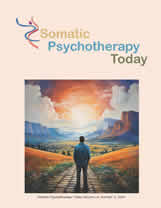Somatic Psychotherapy Today Volume 14, Number 1, 2024
SPT Magazine is pleased to share Volume 14, Number 1, 2024: a compilation of articles and reviews we've posted individually so far this year. As we transition from an independent publication to join with the United States Association for Body Psychotherapy, we look forward to new submissions for Vol. .14, No. 2.
Contemporary Reichian Analysis
Increasing awareness and understanding of epigenetics and neuroplasticity in current research has resulted in a new perspective of psychotherapy that is integrated with neurobiological information. This information is at the root of an emerging paradigm shift in body psychotherapy that I call Evolutive Stage Neuromediator Vegetotherapy.
Polyvagal Prompts: Finding Connection and Joy Through Guided Explorations
Beneath our “level of conscious awareness, our nervous system directs our movement toward and away from people, places, and experiences” (Dana & Rolfe, 2024, pg. 56). And this guidance is critical to our health and well-being. But we aren’t born knowing how to do it. Deb Dana, LCSW, and Courtney Rolfe, LCPC joined forces to write “Polyvagal Prompts: Finding Connection and Joy Through Guided Explorations.” They know we don’t innately know how to self-regulate our physiological and psychological states—we learn by co-regulating with attuned caregivers.
The Mindfulness and Character Strengths Workbook
The Mindfulness and Character Strengths Workbook is everything I hoped for and more. It is a well-written, easy-to-follow, detailed to the nth degree workbook with extensive, free online materials to support the process including audio-guided meditations. Congratulations Ryan on a much-needed workbook to support people exploring character strengths and their integration with mindfulness.
SPT Magazine is pleased to announce the release of Volume 12, Number 1, 2022
SPT Magazine is pleased to announce the release of Volume 12, Number 1, 2022. If you missed any of our articles this year, you can now access the entire year in one downloadable PDF on our website.
Contemporary Reichian Analysis and Character-Analytical Vegetotherapy from 1933 to 2022
In this article, I will introduce a set of grammar clarifying body psychoanalysis, which extends not only to psychopathology, itself primarily interpreted as being bottom-up in terms of evolutive time, but also, to clinical psychotherapy, that follows. Perhaps I am outlining a new position, certainly it takes the Reichian paradigm deeper, or is, rather, a "change in the visual gestalt" as Kuhn might put it. It represents a change in the mental architecture of observation which emerges from a different way of feeling, I might add.
It is a paradigm which reads the unconscious in its entirety, because the unconscious is undoubtedly a "mirror" for what has been deposited in the body.
The Psychology of Meditation: Varieties, Effects, Theories, and Perspectives
Peter Sedlmeier offers a representative overview of meditation with a scientific slant in his new book The Psychology of Meditation. Divided into four parts, the text guides readers through varieties of meditation, the effects of meditation, theories of meditation, and concludes with Part 4: Perspectives. He notes that the first 10 chapters build the foundation to support the endpoint, Chapter 11: Perspectives on Meditation Research.
The Voice as Mask
Masks have fascinated cultures and individuals for centuries. In ancient Greek plays, masks were thought to embody the spirit of the character that the actor played. It was as if the mask itself used the actor to bring the character it represented back to life. The actor could often feel overtaken by the character of the mask. The voice of the actor in the here and now expressed the spirit of the character portrayed. But a mask is more than the physical material, be it leather, Papier-mâché, or terra cotta. It is a representation of the person in appearance and voice. How many disguises live in our voice, our sounds, and sayings?
Tuning Into Gravity
Gravity matters. Not simply to keep us physically grounded here on Earth, but, at a fundamental level, our relationship with gravity affects our lives from start to finish. We start life floating in amniotic fluids. It's easy to assume a sense of buoyancy, free from gravity's impact. Yet, gravity is necessary for our physiological development during the second half of our lives in the womb.
Boundary Boss: The Essential Guide to Talk True, Be Seen, and (Finally) Live Free
By Nancy Eichhorn, Ph.D.
My inner editor smiles (envision a Cheshire Cat grin) when reviewing a new book and its layout includes all the necessary...














